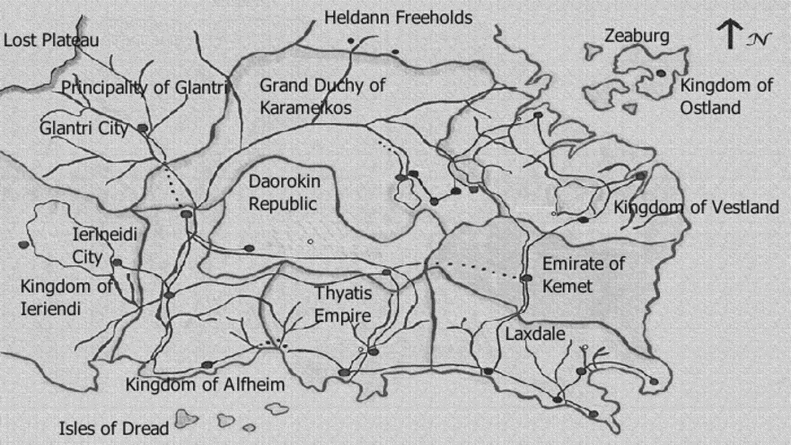
Dear Tracey, I noticed that your Witchcraft Wars books are based upon material that is copyrighted and owned by another company. You seem to have based your works on the World of Mystara, which is a published fantasy setting for the D&D Game, currently copyrighted and trademarked by Wizards of the Coast, based in Renton Wa.
Heard is in a good position to know, he was the product manager for the Mystara line (then known as "The Known World"). Still, that's a very serious implication. Let's compare the map of Alley's Witchcraft Wars novels to the map of Mystara. Here is Alley's map:

(Tracey Alley, Slade's Destiny, 2010. Taken from Amazon.com using the "Look Inside" preview. The image has been rotated, but is otherwise unmodified.)
For comparison, here is a map of Mystara:
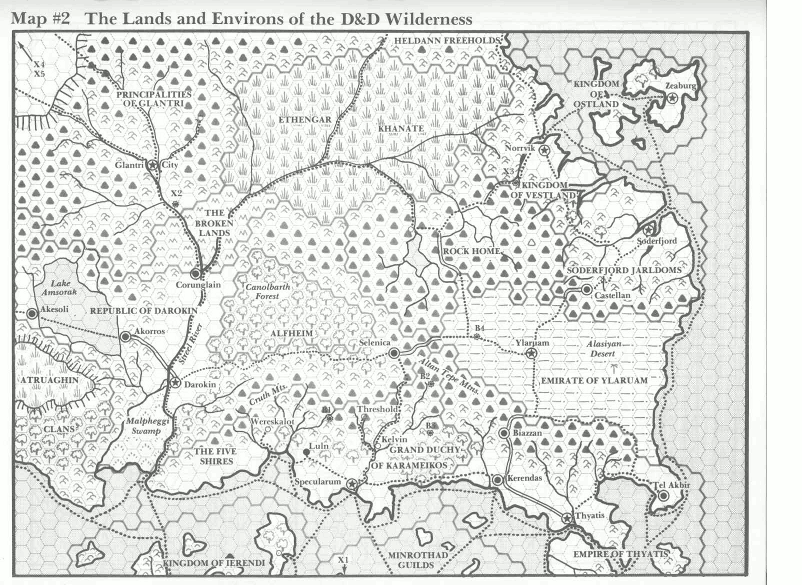
(Artist unknown, from Dungeons & Dragons Expert Set by Gary Gygax and Dave Arneson, TSR, Inc, 1983.)
Those are... very similar. Let's start with the names which appear on both maps and in (generally) roughly the same positions: The Kingdom of Ostland and its capital Zeaburg, the Heldann Freeholds, (the Kingdom of) Alfheim, Grand Duchy of Karameikos, Principality of Glantri and its capital Glantri City, the Republic of Darokin/Darokin Republic, Kingdom of Ierendi/Ieriendi, the Empire of Thyatis/Thyatis Empire, and the Kingdom of Vestland. The X1 on the bottom of the D&:D map refers to the D&D "adventure" Isle of Dread, and it's just about where Alley's Isles of Dread are.
Alley replied to Heard:
No Bruce the work is all original, any similarities are purely coincidental. I'd never even heard of the World of Mystara before you mentioned it.
To be fair, the Mystara is a newer name. It didn't have a name originally, it was simply "the Known World" or "the D&D Wilderness." But it can hardly be coincidental given the similarities.
When she was challenged, the replied with a slightly different story:
When I mentioned certain place names that I did use in my work they relate to very old memories of D&D campaigns played as a teenager - some names tend to stick in the mind. Is it plagiarism to use a person's name in a work of fiction? No and neither is it plagiarism to use place names either.
I am fully conversant with, not only Australian, but International copyright laws and no court has ever held that an author cannot use a name of a person, place or thing named in another work - those are things which fall outside the scope of copyright and fall into public domain usage. That is a FACT and that is the LAW. This means that I have every right to use place names like Karameikos or Glantri and do not deny that I did so in my work. That is not plagiarism as defined by International copyright law.
It's important to clarify some terms.
Simplified, copyright prohibits making copies of someone else's work. If you make prohibited copies, you are engaging in "copyright infringement," which is against the law. Copyright laws are all national, but almost every nation in the world has agreed to certain minimum laws and to respect copyrights from other countries.
Plagiarism is taking credit for someone else's creative work. In the United States (I can't speak to Australia), plagiarism is not a crime. There are certainly no international laws or treaties forbidding plagiarism. Plagiarism is unethical, but not generally illegal.
The key here is that copyright infringement and plagiarism are different things. They are frequently done simultaneously, but not necessarily. If I make a prohibited copy of Harry Potter and the Goblet of Fire, but I leave J. K. Rowlings name on it, I have engaged in copyright infringement but not plagiarism. Conversely, if I quote a single sentence of Goblet of Fire and imply that I wrote it, I have not engaged in copyright infringement, but I have engaged in plagiarism.
Alley seems unaware that there is a difference. She is almost certainly correct that individual nouns, even proper nouns, are not eligible for copyright protection. I believe she has every legal right to use them. But, she is absolutely using someone else's creation without giving them credit. That is plagiarism and unethical. Tracey Alley is absolutely a plagiarist.
Looking back to the maps, let's compare them again. Here I have cleaned up the contrast on Alley's map and stretched it up and down so that it is 128% of its original height.
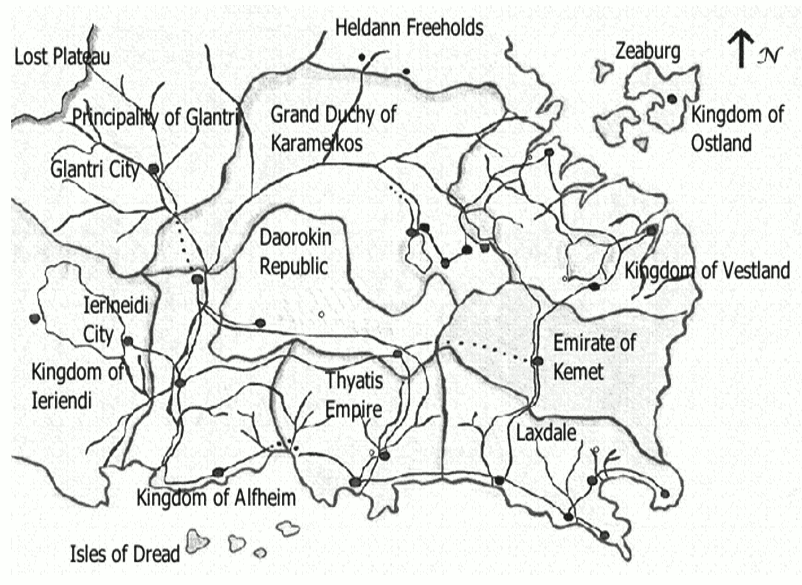
If you have a recent browser, you should be able to click on this map to toggle between it and the D&D map. Note the extreme similarity on the coastlines, the rivers, and the national borders. This simply cannot be chance. What does Alley have to say on the similarities?
I have no idea what the references to the map pertain to - I used an old map that I had used for campaigns when playing D&D many, many years ago. I drew the map myself and it is, in fact, a rough copy of a map of Europe however, once again that is not an act of plagiarism. As I did not use a specifically copyrighted map I am perfectly within my full legal right to use a map, drawn by myself, by roughly using maps of the European continent and then making certain changes.So, I will repeat, for the last time. My work is original, my storyline and characters are my intellectual property and no part of them is the plagiarised work of another author. Nor is it a tracing of another's work.
I have made my position on this matter perfectly clear in my own FB page however I will mention here very quickly that A] my map is actually a rough copy of a map of Europe (possibly the reason they appear to be similar is that your claimed D&D mapmakers used the same trick I did?)
She admits that it's from her campaigns in D&D, "many years ago." Maybe back to the mid-80s, back before Mystara was named, but after it existed? This is evidence that Alley was likely exposed to the original map in question.
As for the claim that it's based on Europe, exactly which portion of Europe? I'm certainly not seeing any similarities. But I'm absolutely seeing incredible similarities to the D&D map. How likely is it that Alley happened to base her map on the same portion of Europe, and to make nearly identical changes to that map as the TSR designer did?
A map, real or fictional, is absolutely subject to copyright. I find it highly likely that Alley based her map on the D&D map. The extreme similarity makes me strongly suspect that she traced the D&D map. It's possible that she copied the map "many, many years ago" and forgot, but it's still a copy. I strongly believe that Tracey Alley has infringed on Wizardshttps://www.facebook.com/permalink.php?story_fbid=661212697225407&id=127959000550782&comment_id=113395660&offset=0&total_comments=21 of the Coast's copyright.
As best I can tell, Tracey Alley is self-publishing her books, using Smashwords to handle it. She may not have handled the design of her covers, but she is responsible for them. And there are a number of cover images that are suspicious.
Here is the cover to An Unholy Encounter. The graphic design is pretty awful, but surprisingly it has a very nice piece of art.
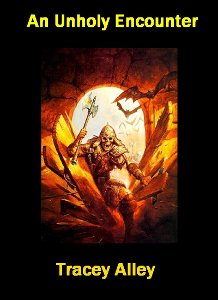
(Cover of An Unholy Encounter by Tracey Alley.)
The art matches the cover from Dragon Magazine, issue 138. I believe it's a piece by Jeff Easley. It's entirely possible she acquired the rights to use this piece on her book, but it would be very surprising if she could afford a relatively famous and high quality piece of art, but not someone to do a nice cover for her.
Here is the cover to A Very Hairy Adventure. Again, terrible graphic design, but a nice piece of art.
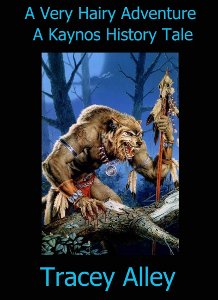
(Cover of A Very Hairy Adventure by Tracey Alley.)
This piece is "Werewolf" by Clyde Caldwell, and it is copyright by White Wolf Game Studio. White Wolf used it as the cover for the Werewolf Storyteller's Handbook. Again, it's possible that she acquired the rights, but I doubt it. She would need White Wolf's permission, and it seems highly unlikely that White Wolf would let someone else use their art.
Here is the cover to The Kaynos History Tales: Vol 1. The cover is inoffensive.
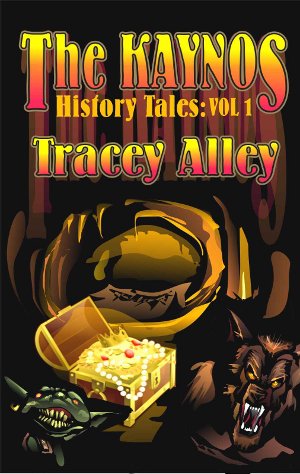
(Cover of The Kaynos History Tales: Vol 1, by Tracey Alley.)
But let's look closer at the figure in the bottom left corner:
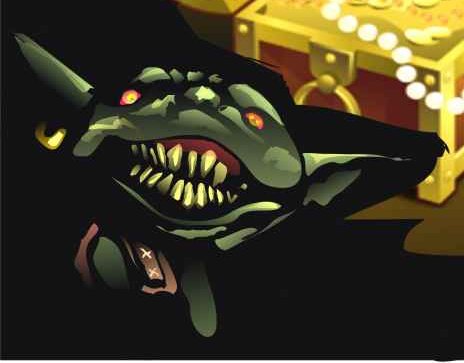
And let's look at piece of art by Andrew Hou for Paizo's Pathfinder line.
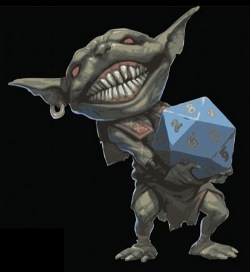
Don't see the similarity? Let's rotate Hou's illustration.
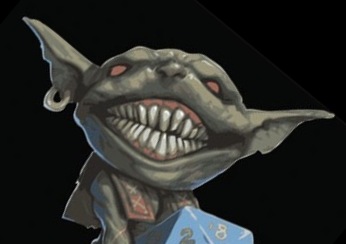
This isn't a direct copy, but it's suspiciously similar. I find it unlikely that Hou based his illustration on the Kaynos image. It seems far more likely that the Kaynos image is based on Hou's illustration. And I'm certain that Paizo would not approve someone using their iconic designs on an unrelated book.
It's possible that the Kaynos version was created by an automated computer program, perhaps one designed to create vector images from raster images. But there are details in the highlighting that don't quite match. I suspect it was created manually, essentially traced.
I find the weight of the evidence damning. Tracey Alley has absolutely engaged in plagiarism by using names created by others without giving them credit. Tracey Alley probably infringed on the copyright of TSR (those rights now held by Wizards of the Coast) by copying their map. Tracey Alley almost certainly infringed on the copyright of White Wolf Game Studio with her cover to A Very Hairy Adventure. Tracey Alley likely infringed on the copyright of either TSR/Wizards of the Coast or Jeff Easley with her cover to An Unholy Night. Tracey Alley may have infringed on the copyright of Paizo or Andrew Hou with her cover to The Kaynos History Tales: Vol 1.
If you are aware of any other evidence that might either show further plagiarism, copyright infringement, or that may exonerate Alley of these claims, please email me.
2013-06-13: Originally written.
This page can be discussed over in my comments. There are currently comments.